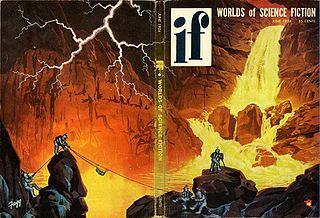Planets in science fiction are fictional planets that appear in various media of the science fiction genre as story-settings or depicted locations.

Gordon Rupert Dickson was a Canadian-American science fiction writer. He was inducted into the Science Fiction and Fantasy Hall of Fame in 2000.
The Childe Cycle is an unfinished series of science fiction novels by Canadian writer Gordon R. Dickson. The name Childe Cycle is an allusion to "Childe Roland to the Dark Tower Came", a poem by Robert Browning, which provided considerable inspiration for elements in Dickson's magnum opus.

Soldier, Ask Not is a science fiction novel by American writer Gordon R. Dickson, published in 1967 by Dell Publishing company. It is also the title of a novella which appeared in the October, 1964 issue of Galaxy Science Fiction magazine. The shorter work constitutes about one third of the novel.
Amanda Morgan is the name of several fictional characters appearing in Gordon R. Dickson's Childe Cycle series of novels and stories. This includes the protagonist of the novella "Amanda Morgan" in The Spirit of Dorsai and The Dorsai Companion.

Fictional depictions of Mercury, the innermost planet of the Solar System, have gone through three distinct phases. Before much was known about the planet, it received scant attention. Later, when it was incorrectly believed that it was tidally locked with the Sun creating a permanent dayside and nightside, stories mainly focused on the conditions of the two sides and the narrow region of permanent twilight between. Since that misconception was dispelled in 1965, the planet has again received less attention from fiction writers, and stories have largely concentrated on the harsh environmental conditions that come from the planet's proximity to the Sun.
Donal Graeme is a fictional character in the Childe Cycle of science fiction novels by Gordon R. Dickson.

Jupiter, the largest planet in the Solar System, has appeared in works of fiction across several centuries. The way the planet has been depicted has evolved as more has become known about its composition; it was initially portrayed as being entirely solid, later as having a high-pressure atmosphere with a solid surface underneath, and finally as being entirely gaseous. It was a popular setting during the pulp era of science fiction. Life on the planet has variously been depicted as identical to humans, larger versions of humans, and non-human. Non-human life on Jupiter has been portrayed as primitive in some works and more advanced than humans in others.
Saturn has made appearances in fiction since the 1752 novel Micromégas by Voltaire. In many of these works, the planet is inhabited by aliens that are usually portrayed as being more advanced than humans. The planet is occasionally visited by humans and its rings are sometimes mined for resources. The moons of Saturn have been depicted in a large number of stories, especially Titan with its Earth-like environment suggesting the possibility of colonization by humans and alien lifeforms living there.
Pluto was discovered in 1930 and has made several appearances in fiction since. It was initially popular as it was newly discovered and thought to be the outermost object of the Solar System. Alien life, sometimes intelligent life and occasionally an entire ecosphere, is a common motif in fictional depictions of Pluto.

NESFA Press is the publishing arm of the New England Science Fiction Association, Inc. The NESFA Press primarily produces three types of books:

Tactics of Mistake is a science fiction novel by American writer Gordon R. Dickson, first published as a serial in Analog in 1970-1971. It is part of Dickson's Childe Cycle series, in which mankind has reached the stars and divided into specialized splinter groups. The fourth book written, it is chronologically the second book of the cycle, occurring roughly a century after Necromancer, and a century before Dorsai!. The primary character, Cletus Grahame, is the ancestor of the key characters in later works: the twins, Ian and Kensie Graeme, and their nephew, Donal Graeme.

Dorsai! is the first published book of the incomplete Childe Cycle series of science fiction novels by American writer Gordon R. Dickson. Later books are set both before and after the events in Dorsai!.
The complete bibliography of Gordon R. Dickson.

Lost Dorsai is a science fiction novella by American writer Gordon R. Dickson. It won the Hugo Award for Best Novella in 1981 and was also nominated for the Nebula Award in 1980.

The Spirit of Dorsai is a collection of two science fiction stories by American writer Gordon R. Dickson. It was first published by Ace Books in 1979. The collection includes linking material and the stories are part of Dickson's Childe Cycle. The first story, "Amanda Morgan", is original to this collection. The other, "Brothers", originally appeared in the anthology Astounding, edited by Harry Harrison.

Lost Dorsai is a collection of science fiction stories by Gordon R. Dickson from his Childe Cycle series. It was first published by Ace Books in 1980. The collection includes two stories that originally appeared in the anthology series Destinies, one that appeared in the magazine Analog Science Fiction and Fact and an excerpt from Dickson's novel The Final Encyclopedia.

The Dorsai Companion is a collection of science fiction stories by American writer Gordon R. Dickson, part of his Childe Cycle series. It was first published by Ace Books in 1986. The collection includes a number of articles by Sandra Miesel.

Necromancer is a science fiction novel by American writer Gordon R. Dickson, published in 1962. It was alternatively titled No Room for Man between 1963 and 1974 before reverting to its original title. It is the prequel to Dickson's earlier novel Dorsai!.
Amanda Morgan is a science fiction novella by American writer Gordon R. Dickson, first published in The Spirit of Dorsai in 1979 and later included in The Dorsai Companion in June 1986. The story is set in 2185 on The Dorsai, a key planet and Splinter Culture of Dickson's future history known as the Childe Cycle. "Amanda Morgan" is a perspective piece expanding and illuminating the crisis of the novel Tactics of Mistake, in which the planet known as The Dorsai is attacked for the sake of defeating Cletus Grahame. Amanda Morgan, also known as The First Amanda, leads the resistance in Grahame's home district. The theme of the story may be understood as: Moral strength is more important than physical strength in the struggle for identity.











